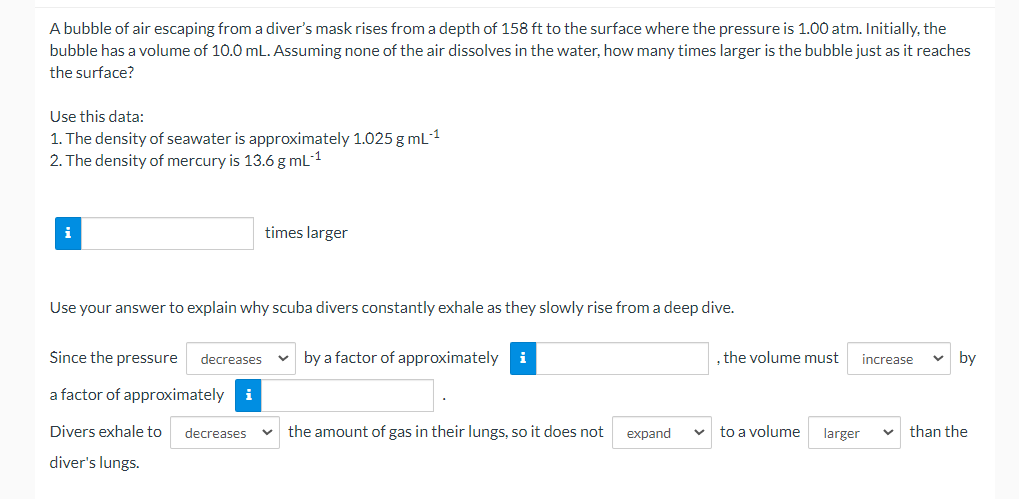A bubble of air escaping from a diver's mask rises from a depth of 158 ft to the surface where the pressure is 1.00 atm. Initially, the bubble has a volume of 10.0 mL. Assuming none of the air dissolves in the water, how many times larger is the bubble just as it reaches the surface? Use this data: 1. The density of seawater is approximately 1.025 g mL1 2. The density of mercury is 13.6 g mL1 i times larger Use your answer to explain why scuba divers constantly exhale as they slowly rise from a deep dive. Since the pressure decreases v by a factor of approximately i ,the volume must v by increase a factor of approximately Divers exhale to decreases the amount of gas in their lungs, so it does not expand to a volume larger than the diver's lungs.
A bubble of air escaping from a diver's mask rises from a depth of 158 ft to the surface where the pressure is 1.00 atm. Initially, the bubble has a volume of 10.0 mL. Assuming none of the air dissolves in the water, how many times larger is the bubble just as it reaches the surface? Use this data: 1. The density of seawater is approximately 1.025 g mL1 2. The density of mercury is 13.6 g mL1 i times larger Use your answer to explain why scuba divers constantly exhale as they slowly rise from a deep dive. Since the pressure decreases v by a factor of approximately i ,the volume must v by increase a factor of approximately Divers exhale to decreases the amount of gas in their lungs, so it does not expand to a volume larger than the diver's lungs.
Chemistry: Principles and Practice
3rd Edition
ISBN:9780534420123
Author:Daniel L. Reger, Scott R. Goode, David W. Ball, Edward Mercer
Publisher:Daniel L. Reger, Scott R. Goode, David W. Ball, Edward Mercer
Chapter12: Solutions
Section: Chapter Questions
Problem 12.106QE: In the 1986 Lake Nyos disaster (see the chapter introduction), an estimated 90 billion kilograms of...
Related questions
Question

Transcribed Image Text:A bubble of air escaping from a diver's mask rises from a depth of 158 ft to the surface where the pressure is 1.00 atm. Initially, the
bubble has a volume of 10.0 mL. Assuming none of the air dissolves in the water, how many times larger is the bubble just as it reaches
the surface?
Use this data:
1. The density of seawater is approximately 1.025g mL1
2. The density of mercury is 13.6 g mL-1
i
times larger
Use your answer to explain why scuba divers constantly exhale as they slowly rise from a deep dive.
Since the pressure
decreases
by a factor of approximately
, the volume must
by
increase
a factor of approximately i
Divers exhale to
decreases
the amount of gas in their lungs, so it does not
expand
to a volume
larger
than the
diver's lungs.
Expert Solution
This question has been solved!
Explore an expertly crafted, step-by-step solution for a thorough understanding of key concepts.
This is a popular solution!
Trending now
This is a popular solution!
Step by step
Solved in 2 steps with 2 images

Knowledge Booster
Learn more about
Need a deep-dive on the concept behind this application? Look no further. Learn more about this topic, chemistry and related others by exploring similar questions and additional content below.Recommended textbooks for you

Chemistry: Principles and Practice
Chemistry
ISBN:
9780534420123
Author:
Daniel L. Reger, Scott R. Goode, David W. Ball, Edward Mercer
Publisher:
Cengage Learning

Chemistry: An Atoms First Approach
Chemistry
ISBN:
9781305079243
Author:
Steven S. Zumdahl, Susan A. Zumdahl
Publisher:
Cengage Learning

Chemistry
Chemistry
ISBN:
9781305957404
Author:
Steven S. Zumdahl, Susan A. Zumdahl, Donald J. DeCoste
Publisher:
Cengage Learning

Chemistry: Principles and Practice
Chemistry
ISBN:
9780534420123
Author:
Daniel L. Reger, Scott R. Goode, David W. Ball, Edward Mercer
Publisher:
Cengage Learning

Chemistry: An Atoms First Approach
Chemistry
ISBN:
9781305079243
Author:
Steven S. Zumdahl, Susan A. Zumdahl
Publisher:
Cengage Learning

Chemistry
Chemistry
ISBN:
9781305957404
Author:
Steven S. Zumdahl, Susan A. Zumdahl, Donald J. DeCoste
Publisher:
Cengage Learning


General, Organic, and Biological Chemistry
Chemistry
ISBN:
9781285853918
Author:
H. Stephen Stoker
Publisher:
Cengage Learning

Chemistry: Principles and Reactions
Chemistry
ISBN:
9781305079373
Author:
William L. Masterton, Cecile N. Hurley
Publisher:
Cengage Learning